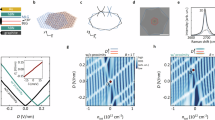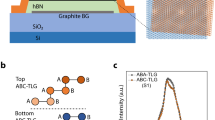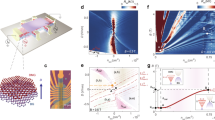Abstract
Graphene1,2,3 is an extraordinary two-dimensional (2D) system with chiral charge carriers and fascinating electronic, mechanical and thermal properties4,5. In multilayer graphene6,7, stacking order provides an important yet rarely explored degree of freedom for tuning its electronic properties8. For instance, Bernal-stacked trilayer graphene (B-TLG) is semi-metallic with a tunable band overlap, and rhombohedral-stacked trilayer graphene (r-TLG) is predicted to be semiconducting with a tunable band gap9,10,11,12,13,14,15,16,17. These multilayer graphenes are also expected to exhibit rich novel phenomena at low charge densities owing to enhanced electronic interactions and competing symmetries. Here we demonstrate the dramatically different transport properties in TLG with different stacking orders, and the unexpected spontaneous gap opening in charge neutral r-TLG. At the Dirac point, B-TLG remains metallic, whereas r-TLG becomes insulating with an intrinsic interaction-driven gap ∼6 meV. In magnetic fields, well-developed quantum Hall (QH) plateaux in r-TLG split into three branches at higher fields. Such splitting is a signature of the Lifshitz transition, a topological change in the Fermi surface, that is found only in r-TLG. Our results underscore the rich interaction-induced phenomena in trilayer graphene with different stacking orders, and its potential towards electronic applications.
This is a preview of subscription content, access via your institution
Access options
Subscribe to this journal
Receive 12 print issues and online access
$259.00 per year
only $21.58 per issue
Buy this article
- Purchase on SpringerLink
- Instant access to full article PDF
Prices may be subject to local taxes which are calculated during checkout




Similar content being viewed by others
References
Zhang, Y. B., Tan, Y. W., Stormer, H. L. & Kim, P. Experimental observation of the quantum Hall effect and Berry’s phase in graphene. Nature 438, 201–204 (2005).
Novoselov, K. S. et al. Two-dimensional gas of massless Dirac fermions in graphene. Nature 438, 197–200 (2005).
Novoselov, K. S. et al. Electric field effect in atomically thin carbon films. Science 306, 666–669 (2004).
Castro Neto, A. H., Guinea, F., Peres, N. M. R., Novoselov, K. S. & Geim, A. K. The electronic properties of graphene. Rev. Mod. Phys. 81, 109–162 (2009).
Das Sarma, S., Adam, S., Hwang, E. H. & Rossi, E. Electronic transport in two dimensional graphene. Rev. Mod. Phys. 83, 407–470 (2011).
Liu, Y. P., Goolaup, S., Murapaka, C., Lew, W. S. & Wong, S. K. Effect of magnetic field on the electronic transport in trilayer graphene. ACS Nano 4, 7087–7092 (2010).
Zhu, W. J., Perebeinos, V., Freitag, M. & Avouris, P. Carrier scattering, mobilities, and electrostatic potential in monolayer, bilayer, and trilayer graphene. Phys. Rev. B 80, 235402 (2009).
Mak, K. F., Shan, J. & Heinz, T. F. Electronic structure of few-layer graphene: Experimental demonstration of strong dependence on stacking sequence. Phys. Rev. Lett. 104, 176404 (2010).
Guinea, F., Castro Neto, A. H. & Peres, N. M. R. Electronic states and Landau levels in graphene stacks. Phys. Rev. B 73, 245426 (2006).
Aoki, M. & Amawashi, H. Dependence of band structures on stacking and field in layered graphene. Solid State Commun. 142, 123–127 (2007).
Koshino, M. & McCann, E. Gate-induced interlayer asymmetry in ABA-stacked trilayer graphene. Phys. Rev. B 79, 125443 (2009).
Craciun, M. F. et al. Trilayer graphene is a semimetal with a gate-tunable band overlap. Nature Nanotech. 4, 383–388 (2009).
Zhang, F., Sahu, B., Min, H. K. & MacDonald, A. H. Band structure of ABC-stacked graphene trilayers. Phys. Rev. B 82, 035409 (2010).
Manes, J. L., Guinea, F. & Vozmediano, M. A. H. Existence and topological stability of Fermi points in multilayered graphene. Phys. Rev. B 75, 155424 (2007).
Latil, S. & Henrard, L. Charge carriers in few-layer graphene films. Phys. Rev. Lett. 97, 036803 (2006).
Koshino, M. Interlayer screening effect in graphene multilayers with ABA and ABC stacking. Phys. Rev. B 81, 125304 (2010).
Avetisyan, A. A., Partoens, B. & Peeters, F. M. Stacking order dependent electric field tuning of the band gap in graphene multilayers. Phys. Rev. B 81, 115432 (2010).
Zhang, F., Jung, J., Fiete, G. A., Niu, Q. A. & MacDonald, A. H. Spontaneous quantum Hall states in chirally stacked few-layer graphene systems. Phys. Rev. Lett. 106, 156801 (2011).
Lui, C. H. et al. Imaging stacking order in few-layer graphene. Nano Lett. 11, 164–169 (2011).
Martin, J. et al. Observation of electron–hole puddles in graphene using a scanning single electron transistor. Nature Phys. 4, 144–148 (2008).
Du, X., Skachko, I., Barker, A. & Andrei, E. Y. Approaching ballistic transport in suspended graphene. Nature Nanotech. 3, 491–495 (2008).
Bolotin, K. I., Sikes, K. J., Hone, J., Stormer, H. L. & Kim, P. Temperature-dependent transport in suspended graphene. Phys. Rev. Lett. 101, 096802 (2008).
Nandkishore, R. & Levitov, L. Quantum anomalous Hall state in bilayer graphene. Phys. Rev. B 82, 115124 (2010).
Vafek, O. & Yang, K. Many-body instability of Coulomb interacting bilayer graphene: Renormalization group approach. Phys. Rev. B 81, 041401 (2010).
Zhang, F., Min, H., Polini, M. & MacDonald, A. H. Spontaneous inversion symmetry breaking in graphene bilayers. Phys. Rev. B 81, 041402 (2010).
Weitz, R. T., Allen, M. T., Feldman, B. E., Martin, J. & Yacoby, A. Broken-symmetry states in doubly gated suspended bilayer graphene. Science 330, 812–816 (2010).
McClure, J. W. Diamagnetism of graphite. Phys. Rev. 104, 666–671 (1956).
McCann, E. & Fal’ko, V. I. Landau-level degeneracy and quantum Hall effect in a graphite bilayer. Phys. Rev. Lett. 96, 086805 (2006).
Ezawa, M. Intrinsic Zeeman effect in graphene. J. Phys. Soc. Jpn 76, 094701 (2007).
Koshino, M. & McCann, E. Trigonal warping and Berry’s phase N π in ABC-stacked multilayer graphene. Phys. Rev. B 80, 165409 (2009).
McCann, E. & Koshino, M. Spin–orbit coupling and broken spin degeneracy in multilayer graphene. Phys. Rev. B 81, 241409 (2010).
Bao, W. et al. Magnetoconductance oscillations and evidence for fractional quantum Hall states in suspended bilayer and trilayer graphene. Phys. Rev. Lett. 105, 246601 (2010).
Abanin, D. A. & Levitov, L. S. Conformal invariance and shape-dependent conductance of graphene samples. Phys. Rev. B 78, 035416 (2008).
Lemonik, Y., Aleiner, I. L., Toke, C. & Fal’ko, V. I. Spontaneous symmetry breaking and Lifshitz transition in bilayer graphene. Phys. Rev. B 82, 201408 (2010).
Bao, W. Z. et al. Lithography-free fabrication of high quality substrate-supported and freestanding graphene devices. Nano Res. 3, 98–102 (2010).
Acknowledgements
This work was supported in part by ONR/DMEA H94003-10-2-1003, NSF CAREER DMR/0748910, ONR N00014-09-1-0724, and the FENA Focus Center. D.S. acknowledges the support by NHMFL UCGP #5068. The trenches are fabricated at UCSB. Part of this work was performed at NHMFL which is supported by NSF/DMR-0654118, the State of Florida, and DOE. S.B.C. acknowledges the support by ONR/N00014-10-1-0511. M.K. and E.M. acknowledge the support by JST-EPSRC EP/H025804/1.
Author information
Authors and Affiliations
Contributions
C.N.L. and W.B. conceived the experiments; W.B. and D.T. isolated and identified graphene sheets; W.B., L.J., Y.L., J.V., G.L, B.S. and D.S. performed transport measurements; W.B., L.J., M.A. and S.B.C. performed Raman measurements; C.N.L., M.B., W.B., L.J. and J.V. interpreted and analysed the data; M.K. and E.M. interpreted data and performed theoretical calculations; C.N.L., M.B., W.B. and E.M. co-wrote the paper. All authors discussed the results and commented on the manuscript.
Corresponding author
Ethics declarations
Competing interests
The authors declare no competing financial interests.
Supplementary information
Supplementary Information
Supplementary Information (PDF 1213 kb)
Rights and permissions
About this article
Cite this article
Bao, W., Jing, L., Velasco, J. et al. Stacking-dependent band gap and quantum transport in trilayer graphene. Nature Phys 7, 948–952 (2011). https://doi.org/10.1038/nphys2103
Received:
Accepted:
Published:
Issue date:
DOI: https://doi.org/10.1038/nphys2103
This article is cited by
-
Fractional quantum anomalous Hall effect in multilayer graphene
Nature (2024)
-
Plasmon-Enhanced Infrared Absorption in Graphene Nanodot Array
Plasmonics (2023)
-
MoS2/PEDOT:PSS nanocomposite films for deep UV sensing: role of the radiation-induced trapping and localization of charges
Applied Physics A (2023)
-
Intercalation as a versatile tool for fabrication, property tuning, and phase transitions in 2D materials
npj 2D Materials and Applications (2021)
-
Gate-tunable charge carrier electrocaloric effect in trilayer graphene
Scientific Reports (2021)



